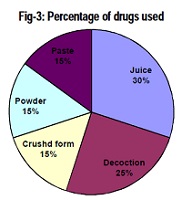Ethnobotanical study of Penchalakona forest area of Nellore District, Andhra Pradesh, India
Keywords:
Ethnobotanical, Penchalakona forestAbstract
An ethno botanical survey was undertaken to collect information from yanadi tribe of penchalakona forest area, Rapur mandal, Nellore district, Andhra Pradesh, India. The indigenous knowledge of traditional healers of this ethnic group has been disappearing due to lack of ancestors as well as followers. Only few people are practicing with little knowledge which was transmitted orally from their elders. The native plants used for medicinal purposes by few people were collected through questionnaire and personally interviewed during field trips. An aboriginal tribe called “Yanadi”, of this area has authentic information on medicinal values of different plant species. Yanadi tribal community being drifted from their natural way of life due to agro rural development activities, a few aged persons are still able to furnish very little traditional ethno botanical data and continue to depend on medicinal plants atleast for the treatment of primary healthcare. Because the area is located near the forest and 70 Kms from Nellore town.The study revealed that, the Yanadi tribe used 20 plants species belonging to 20 families to treat various diseases like worm infestations, scorpion stinge, headache, body pains, fevers, swelling of foots, skin diseases, heart diseases, stomach ulcers, diuretic, dysentery, snake bites, nerve disorders, rheumatic pains, antiseptic, helmentic disease, diabetes, cold and dental problems.These plants represents the major source for the pharmaceutical industries in view of their raw material. The information requires validation for further clinical usage.
References
. Abu-Rabia A: Urinary diseases and
ethnobotany among pastoral
nomads in the Middle East. Journal
of Ethnobiology and Ethnomedicine
,
:4(http://www.ethnobiomed.com/co
ntext/1/14).
. Akerete, O. 1992. WHO guidelines
for assessment of herbal medicines.
Fitoterpia 63: 99-118.
. Anonymous, 1990. Ethnobiology in
India: A status Report. Ministry of
Environment and Forests, Govt. of
India, New Delhi, 1-68 pp.
. Azaizeh H, Fulders, Khalil K, Said O:
Ethnomedicinal knowledge of local
Arab practitioners in the Middle East
Region. Fitoterapia 2003, 74: 98-
. Chellaiah Muthu, Muniappan
Ayyanar, Nagappan Raja and
Sararimuthu Ignacimuthu: Medicinal
Plants used by traditional healers in
Kancheepuram District of Tamil
Nadu, India. Journal of Ethnobiology
and Ethnomedicine, 2006, 2: 43.
. Gamble J.S.,1915-1936.Flora of the
Presidency of Madras,Vol.1-
Authority of the Secretary of State
for India in council,Dehra
Dun,India,pp.5-1597.
. Huxley, A. 1984. Green inheritance:
The World Wildlife Fund Book of
India, Collins/ Harvel, London.
. Jain, S.K., 1989 (ed.) Methods and
approaches in Ethnobotany.
Society of Ethnobotanists, Lucknow.
. Khan AV: History of decline and
present status of natural tropical
thorn forest in Punjab. Pakistan
Biological conservation 2002,
:210-250.
. Pei Sj: Ethnobotanical approaches
of traditional medicine studies:
Some experiences from Asia.
Pharmaceutical Biology 2001, 39:
-79.
. Rajasekaran, B and D.M. Warren
Indigenous knowledge for
socio-economic development and
biodiversity conservation: the Kolli
hills. Indigenous knowledge and
Development Monitor 2: 13-17.
. Ripu M Kunwar and Rainer W
Bussmann : Ethnobotany in the
Nepal Himalaya. Journal of
Ethnobiology and Ethnomedicine
, 4:24
. Sati SC, Sati N, Rawat U and Sati
OP, Medicinal Plants as a source of
antioxidants, Res. J. Phytochems, 4,
, 213-224.
. Satyavathi GV, Gupta AK and
Tandom N, Medicinal Plants of
India, Indian council of Medical
Research, New Delhi, India, 1987.
. Savithramma N, Sulochana Ch,
Rao K.N:Ethnobotanical survey of
plants used to treat asthma in
Andhra Pradesh ,India.Journal of
Ethnopharmacology 113(2007)54-
. Savithramma N, Linga Rao M,
Suhrulatha D. 2011. Screening of
Medicinal plants for secondary
metabolites. Middle-East J. Sci.
Res:8, 579-584.
. Singh SP, Tripathi S and Shukla RS
(2003). Ethnomedicinal heritage for
Bio-prospecting and Drug
development in North-Eastern
States of India. Journal of
Economic and Taxonomic Botany
: 384-395.
. Venkata subbaiah K.P and
Savithrmma N:Bio-prospecting and
documentation of traditional plants
used to treat itching,psoriasis and
wounds by ethnic groups of Kurnool
district,Andhra Pradesh,India.Asian
journal of pharmaceutical and
clinical research vol 5,issue 2,2012.
. Yogamaya Dhal, Rajani K Sahu and
Bandita Deo: Ethnomedicinal survey
of Koraput District, Odisha: An
Update. Journal of Pharmacy
Research 2011, 4 (11), 4142-4145.



